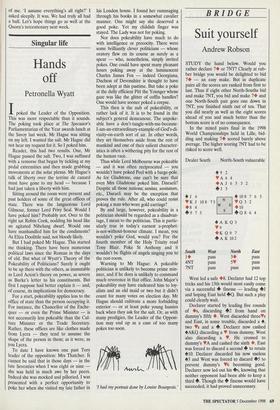BRIDGE
Suit yourself
Andrew Robson
STUDY the hand below. Would you rather declare 74 or 7NT? Clearly at rub- ber bridge you would be delighted to bid 7* — an easy make. But in duplicate pairs all the scores are ranked from first to last. Thus if eight other North-Souths bid and make 7NT, you bid and make 7* and one North-South pair goes one down in 7NT, you finished ninth out of ten. That you did nearly as well as the eight scores ahead of you and much better than the bottom score is of no consequence.
In the mixed pairs final in the 1998 World Championships held in Lille, bid- ding and making 74 scored barely above average. The higher scoring 7NT had to be risked to score well.
Dealer South North-South vulnerable 49 2 V A 6 4 • A J 6 5 3 2
J 3 • J 4 4 10 8 7 6 5
N
K J 108 75 V Q 3 2 • 8 4
W E
• 10 49 7
5
4 Q 8 6 4 • A K Q 3 9 • K Q 9 7 4 A K 102 South West North . East 1* pass 3 • pass 4NT pass 5 V pass 7NT pass pass pass West led a safe 48. Declarer had 12 top tricks and his 13th would most easily come via a successful 4 finesse — leading 4J and hoping East held 4Q. But such a play could clearly wait.
Declarer started by leading five rounds of •s, discarding 42 from hand on dummy's fifth 4. West discarded threeVs and East, in some trouble, discarded a 4, two Vs and a 4. Declarer now cashed 4AKQ discarding a V from dummy, West also discarding a V. He crossed to dummy's VA and cashed the sixth •. East was forced to discard a second 4 to retain 410. Declarer discarded his now useless 43 and West was forced to discard 45 to prevent dummy's V6 becoming good. Declarer now led out his 4s, knowing that neither opponent had been able to keep a third 4. Though the 4 finesse would have succeeded, it had proved unnecessary.


















































































 Previous page
Previous page